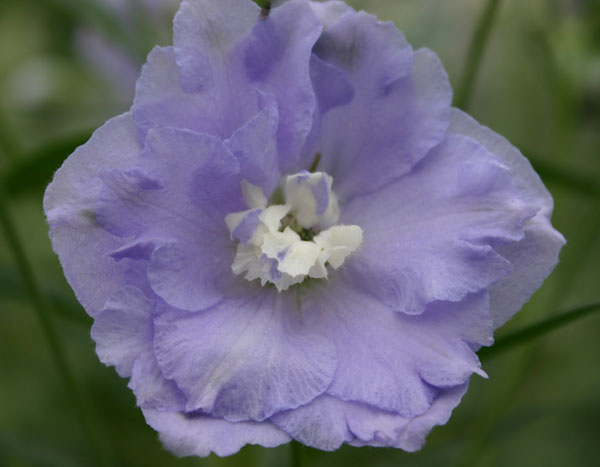Delphinium
|
This is a large group of very beautiful annuals and perennials commonly called Larkspurs. The original or wild types from which the named varieties are descended are natives of California, Siberia, Syria and India. The Delphiniums mostly seen in gardens are hybrids of D. elatum and are clump-forming perennials that bloom from early to mid-summer. Their leaves are divided, lobed, and range from mid- to bright green. Hybrids of D. belladonna are also clump-forming perennials, but with more thin, wiry stems that produce branched spikes of spurred flowers. Dwarf annual Delphiniums are descended from D. Ajacis and tall annual Larkspurs from D. Consolida. The height of the different varieties ranges from 3 to 8 feet, with some dwarf varieties only growing up to 18 inches high. The flowers of these plants grow in long spikes. They are cup-shaped and may be single or double with colors ranging from creamy-whites through lilac-pinks to dark indigo-blue, usually with a contrasting "eye" formed by the inner sepals. D. 'Strawberry Fair' has large, semi-double, mulberry-pink flowers with white eyes on plants that grow 5� to 6 feet high. D. 'Sungleam' has large, semi-double, white overlaid with pale yellow flowers with yellow eyes. D. 'Blue Nile' grows from 5 to 5� feet high and produces large, semi-double rich, dark blue flowers with blue-streaked white eyes. D. grandiflorum 'Blue Butterfly' only grows 18 inches high and has single, dark blue flowers, growing 1� inches across. They are produced in airy, branching spikes up to 6 inches long. The bright green leaves are palmately divided. D. 'Spindrift' is an interesting plant with large, semi-double flowers that grow in 3-foot long spikes. They are a pinkish-lilac color overlaid with pale blue with creamy-white eyes, which have a deep blue center. On acidic soils, the petals become tinged with green. Other kinds will be described below in the varieties section.
Pot CultivationLarkspurs need deeply dug, fertile, moist soil that is well-drained and a position in full sun with shelter from strong winds. Decayed manure or compost should be mixed into the lower soil and compost and bone meal with the upper layer. Planting may be done in early fall or spring. They should be placed 2 or 3 feet apart according to the eventual height of the variety. These plants, except for the dwarf varieties, will need to be staked; the lower growing hybrids with twiggy sticks and the taller ones with stakes or "grow-through" supports. The supports should be inserted by the time the plants reach a foot high to prevent damage. While they are growing actively, especially in the spring and early summer, they need a lot of water and weekly applications of a balanced liquid fertilizer. The shoots should be thinned out to 2 or 3 on young plants and 5 to 7 on established plants, once they have reached 3 inches in height. This promotes high quality flowers. When the flowers die, cut back the spikes to the smaller, branching sideshoots. Well-fed and watered plants will produce a second, smaller crop of flowers in late summer. All growth on the perennials should be cut back in the fall. When Delphiniums begin to grow in the spring, the young shoots are susceptible to attack from slugs, especially in weather that is damp or wet. Old sifted ashes placed around and among the shoots will protect them from serious damage. A mixture of equal parts of copper sulphate and hydrated lime on the soil around, but not touching the plants will also protect them. It is beneficial, if every spring, decayed manure and bone meal is placed around the plants and forked lightly into the ground. Perennial and annual Larkspurs may be grown as pot plants in greenhouses that have full exposure to the sun. They should be grown in light, well drained, fertile soil. These plants provide beautiful cut flowers. PropagationD. elatum and D. belladonna and their varieties may be increased by taking heeled basal cuttings, 3 to 4 inches long, in early spring. D. belladonna and hybrids can be increased by division. Seeds may also be sown in sifted sandy soil. When growing Larkspur in a greenhouse, seeds of the annual kinds should be sown in well-drained flats or small pots filled with porous, fertile soil. They should be transferred to larger pots eventually ending up with a container 6 to 8 inches in diameter. Once the containers are filled with roots, they should be given dilute liquid fertilizer every week. Don't let the soil dry out but don't saturate it either. The plants will need to be staked and tied.
VarietiesPerennials - D. Brunonianum; D. cardinale; D. grandiflorum & var. Blue Butterfly; D. nudicaule; D. sulphureum. Hybrid perennials - D. Butterball; D. Sandpiper; D. Olive Poppleton; D. Emily Hawkins; D. Langdon's Royal Flush; D. Fanfare; D. Strawberry Fair; D. Gillian Dallas; D. Mighty Atom; D. Spindrift; D. Bruce; D. Blue Dawn; D. Belladonna Blue Bee; D. Lord Butler; D. Chelsea Star; D. Loch Leven; D. Blue Nile; D. Sungleam. |






